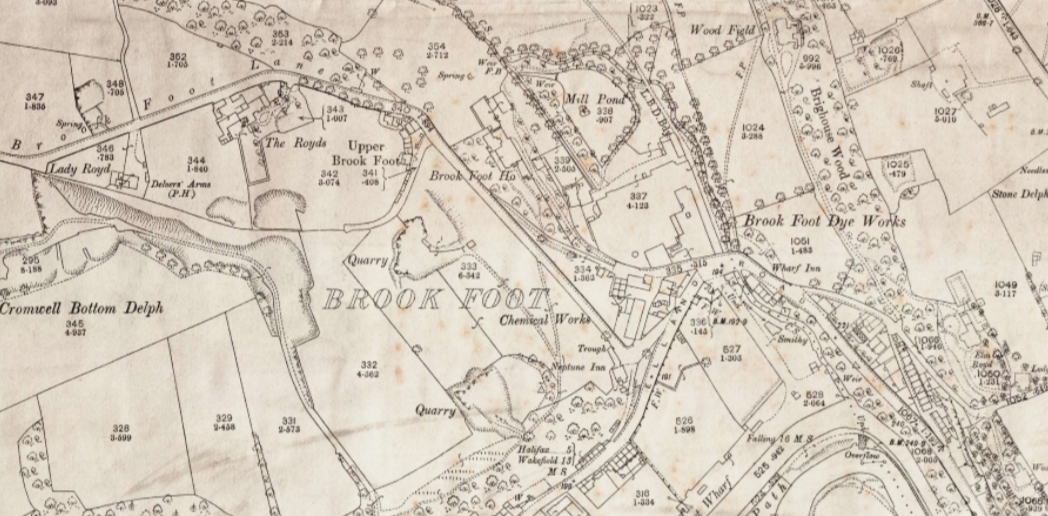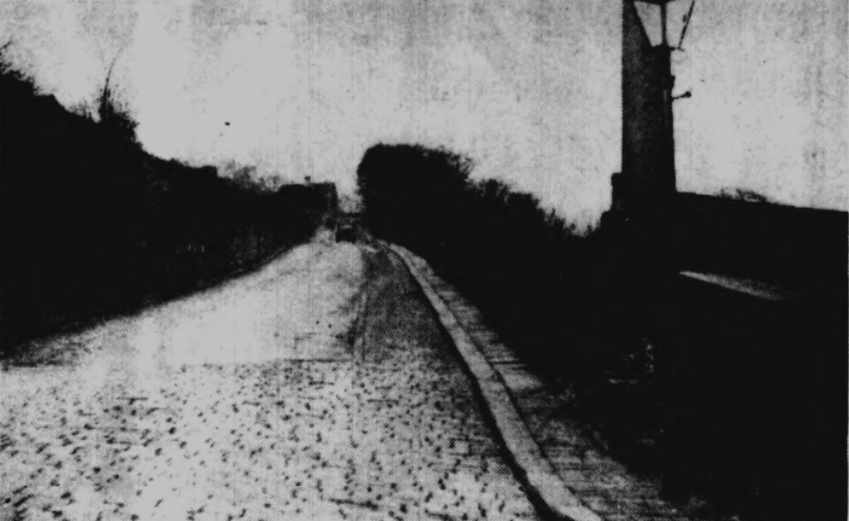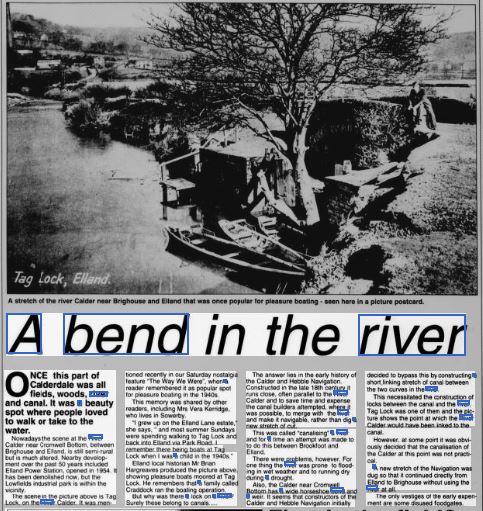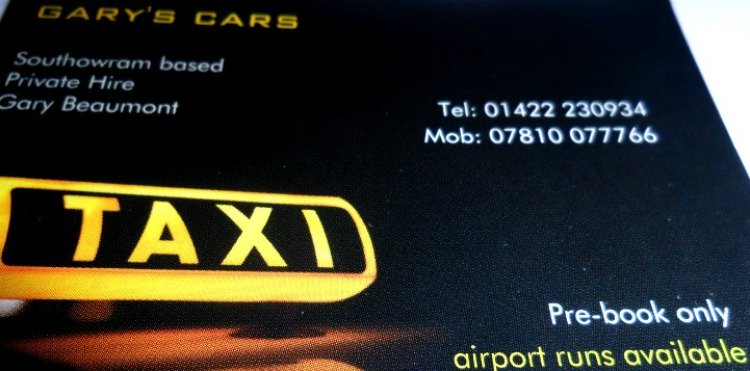Southowram History 17 - Brookfoot Bottom
Southowram History 17 - Brookfoot Bottom

 |
 |


From the bottom of Brookfoot Lane we can turn left towards Brighouse or right towards Elland.

 |
 |


We'll travel left first

Brookfoot House

Brookfoot House and lake that no longer exists in Brookfoot Works







Looking towards Brookfoot mills and Cromwell from Wood Bottom










This horse and cart are travelling towards Brighouse

Ganny Lock with the Vine Hotel (top right)

Vine Hotel from road side

The pub on the right was the 'Football Inn'

This is taken as you are just heading away from Brighouse(roundabout) towards Brookfoot

Bottom of Halifax Road(right) and Elland Road leads towards Brookfoot
Remembering
the great days at Brookfoot
The recent announcement of the closure of the Brookfoot Company gave rise to nostalgic reflections, since many generations of Brighouse people were employed there, many for the whole of their working lives. It was proudly said of any kind of cloth: "If it could be woven, Brookfoot could dye and finish it".
Its history goes back to 1870, when Mr Joe Richardson started at Brookfoot because he saw the potential of the site, fed by a constant supply of soft water from the Shibden and Walterclough valleys and the Pennine Hills beyond. The company was sold in 1894 to Mr Hannam and became Thornton, Hannam and Marshall.
The owner of the company, which provided ever-increasing employment locally, lived on the premises in a large house, better described as a mansion, known as Brookfoot House. It was situated in the lee of the hillside that formed Brookfoot Hill, the road up to Southowram. The water storage dam was built on the site of his ornamental lake, and the mansion fell into decay.
By the turn of the 19th century the dyeworks at Brookfoot had joined the Bradford Dyers Association (BDA) along with 20 other companies. One of the original BDA companies was Edward Ripley's in West Bowling, Bradford. Another company which joined the BDA was the Craven Dyeing Company further up the valley.
The famous red seal of the BDA was a familiar sight in the area.
Despite this expensive solution to the power problems, Craven Dyeing Company failed and was closed down. In 1957, it was decided to merge Ripleys and Thornton, Hannam and Marshall's on the Brookfoot site to use the modern power plant. It became Brookfoot
Limited.Woollen fabrics were slowly being replaced by newer synthetic cloths like Terylene and Acrilan. In 1964 the BDA was taken over by Joe Hyman and Viyella International who produced a variety of synthetic fabrics, such as 'Everprest' for gents washable trousers. A few years later Carrington and Dewhirst joined Viyella and became Carrington Viyella. The dyeworks became the Brookfoot Company.
Because of the new fabrics it was decided about three years ago to introduce new machinery into the original Craven Dyeing Works at a cost of £ ¾ million and to demolish the Brookfoot Company site.
One
thinks of the days when it was customary to take dad's dinner to the
mill in a basin wrapped in the familiar spotted red handkerchief
before canteens were thought of. The factory buzzers which were so
ridiculously loud that they frightened dogs and children. One small
boy was going down Brighouse Wood Lane from Lane Head to the dyeworks
with his dad's dinner, the buzzer blew, and the poor little soul flew
on to his backside. He arrived at the works with gravy dripping
through that red cloth.
Now we are back at the bottom of the notorious Brookfoot Hill. We shall witness the scenes of some of the accidents that have occurred over the years due to the steepness of the hill and then we shall travel right towards Brookfoot village, on towards Cromwell Bottom as we head towards Elland.













The recent announcement of the closure of the Brookfoot Company gave rise to nostalgic reflections, since many generations of Brighouse people were employed there, many for the whole of their working lives. It was proudly said of any kind of cloth: "If it could be woven, Brookfoot could dye and finish it".
Its history goes back to 1870, when Mr Joe Richardson started at Brookfoot because he saw the potential of the site, fed by a constant supply of soft water from the Shibden and Walterclough valleys and the Pennine Hills beyond. The company was sold in 1894 to Mr Hannam and became Thornton, Hannam and Marshall.
The owner of the company, which provided ever-increasing employment locally, lived on the premises in a large house, better described as a mansion, known as Brookfoot House. It was situated in the lee of the hillside that formed Brookfoot Hill, the road up to Southowram. The water storage dam was built on the site of his ornamental lake, and the mansion fell into decay.
By the turn of the 19th century the dyeworks at Brookfoot had joined the Bradford Dyers Association (BDA) along with 20 other companies. One of the original BDA companies was Edward Ripley's in West Bowling, Bradford. Another company which joined the BDA was the Craven Dyeing Company further up the valley.
The famous red seal of the BDA was a familiar sight in the area, it Despite this expensive solution to the power problems, Craven Dyeing Company failed and was closed down. In 1957, it was decided to merge Ripleys and Thornton, Hannam and Marshall's on the Brookfoot site to use the modern power plant. It became Brookfoot
Limited.Woollen fabrics were slowly being replaced by newer synthetic cloths like Terylene and Acrilan. In 1964 the BDA was taken over by Joe Hyman and Viyella International who produced a variety of synthetic fabrics, such as 'Everprest' for gents washable trousers. A few years later Carrington and Dewhirst joined Viyella and became Carrington Viyella. The dyeworks became the Brookfoot Company.
Because of the new fabrics it was decided about three years ago to introduce new machinery into the original Craven Dyeing Works at a cost of £ ¾ million and to demolish the Brookfoot Company site.
One thinks of the days when it was customary to take dad's dinner to the mill in a basin wrapped in the familiar spotted red handkerchief before canteens were thought of. The factory buzzers which were so ridiculously loud that they frightened dogs and children. One small boy was going down Brighouse Wood Lane from Lane Head to the dyeworks with his dad's dinner, the buzzer blew, and the poor little soul flew on to his backside. He arrived at the works with gravy dripping through that red cloth.

The man who would one day sign himself Dr. B.E.J. Edwards, was born Bodgan Edward Jastrzebski in 1860, the son of a Polish immigrant to Halifax. Always a promising scholar, he qualified in medicine from the University of Edinburgh in 1884. It is possible that during his time there he rubbed shoulders with Arthur Conan Doyle who was three years his senior, whilst he almost certainly studied under Dr. Joseph Bell, the inspiration for Doyle’s most famous creation, Sherlock Holmes.
Shortly after qualifying, he changed his surname to Edwards, finding his Polish moniker a hindrance to his medical career. After several years serving as a house surgeon at Halifax Infirmary, he established a general practice, initially operating from 138 Elland Road at Brookfoot, where he resided with his new family. The house stood at the bottom of Freeman’s Woods opposite North Cut and whilst the row was demolished in the 1960s, its ivy-swathed ruins are still visible from the roadside.
Brookfoot at the time was a thriving community, with its own Methodist chapel, Co-op store, school and an abundance of pubs. One such establishment, The Woodman, stood on the corner of North Cut, opposite Edwards’ practice. An outbuilding there often functioned as an impromptu morgue for the bodies of suicides dredged from the Calder, an act for which the riverbank at Brookfoot was notorious. It seems inevitable that as the village doctor, Edwards will have been called to attend such incidents.
Edwards’ career went from strength to strength and in 1895, he was appointed Medical Officer of Health for Southowram (which at that time included Brookfoot). By 1901, he had moved to larger premises at 46 Bradford Road and later took the role of Medical Officer for Brighouse, Clifton and Hartshead. During the First World War, he established military hospitals at Longroyde in Brighouse and Boothroyd in Rastrick, for which he was awarded an MBE in 1920. He died in 1923, following a short illness.

from Ghosts and Legends of the Lower Calder Valley
Please visit a friends (Rastrick based) website by clicking the link below

Historic photographs of Calder & Hebble Navigation - Brighouse to Elland (myrastrick.com)
Return to Southowram History 16 - Brookfoot (Top)
Continue to Southowram History 18 - Brookfoot Village
Continue to Brighouse History
If you have enjoyed your visit to this website, please spread the word by clicking the 'like' and 'share' buttons below. Thank you
